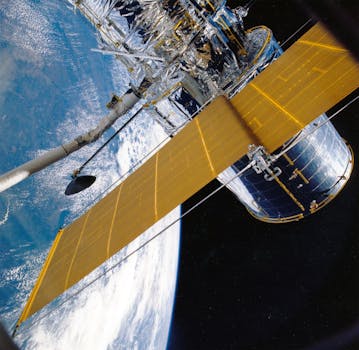Exploring the World of GEO Satellites

GEO Satellites: Introduction to a Crucial Component of Modern Telecommunications
GEO satellites, or Geostationary Earth Orbit satellites, are a type of satellite that orbits the Earth at an altitude of approximately 36,000 kilometers, remaining stationary relative to a fixed point on the Earth’s surface. This unique characteristic allows GEO satellites to provide continuous coverage of a specific region, making them an essential component of modern telecommunications. The focus keyword for this article is GEO satellites, and we will explore their history, applications, and future developments in the following sections.
The concept of GEO satellites was first proposed by scientist Arthur C. Clarke in 1945, and the first GEO satellite, Syncom 2, was launched in 1963. Since then, GEO satellites have become increasingly important for telecommunications, navigation, and weather forecasting. Today, there are hundreds of GEO satellites in orbit, providing a wide range of services, including television broadcasting, internet connectivity, and mobile communications.
Applications of GEO Satellites
GEO satellites have a wide range of applications, including telecommunications, navigation, and weather forecasting. One of the primary uses of GEO satellites is for television broadcasting, allowing stations to transmit their signals to a wide audience. GEO satellites are also used for internet connectivity, providing access to remote and underserved areas. In addition, GEO satellites play a critical role in navigation, providing location information and timing signals for GPS and other navigation systems.
GEO satellites are also used for weather forecasting, providing imagery and data that help meteorologists predict weather patterns and track severe weather events. Furthermore, GEO satellites are used for Earth observation, providing valuable data on the environment, climate change, and natural resources. The use of GEO satellites has also expanded into the field of space exploration, with many satellites being used to study the Earth’s magnetic field, the Sun, and the universe.
Future Developments in GEO Satellites
As technology continues to evolve, GEO satellites are becoming increasingly advanced, with new developments in areas such as satellite design, propulsion systems, and payload capacity. One of the latest trends in GEO satellites is the use of high-throughput satellites (HTS), which offer faster data transfer rates and higher bandwidth. HTS satellites are being used for a variety of applications, including broadband internet access, mobile communications, and television broadcasting.
Another area of development in GEO satellites is the use of electric propulsion systems, which offer greater fuel efficiency and longer mission durations. Electric propulsion systems are being used in a variety of GEO satellites, including those used for telecommunications, navigation, and Earth observation. In addition, there is a growing trend towards the use of smaller, more affordable GEO satellites, which are being used for a variety of applications, including CubeSats and small satellite constellations.
Challenges and Opportunities in the GEO Satellite Industry
Despite the many advances in GEO satellite technology, there are still several challenges facing the industry. One of the primary challenges is the increasing competition from other types of satellites, such as low-Earth orbit (LEO) satellites and medium-Earth orbit (MEO) satellites. LEO satellites, in particular, are becoming increasingly popular, with many companies launching constellations of small satellites to provide global coverage.
Another challenge facing the GEO satellite industry is the issue of space debris, with many satellites and other objects in orbit posing a collision risk to operational satellites. To address this issue, many companies and organizations are working to develop sustainable practices for satellite operations, including the use of de-orbiting technologies and responsible satellite design. Despite these challenges, the GEO satellite industry is expected to continue growing, with many new opportunities emerging in areas such as 5G connectivity, IoT, and space exploration.